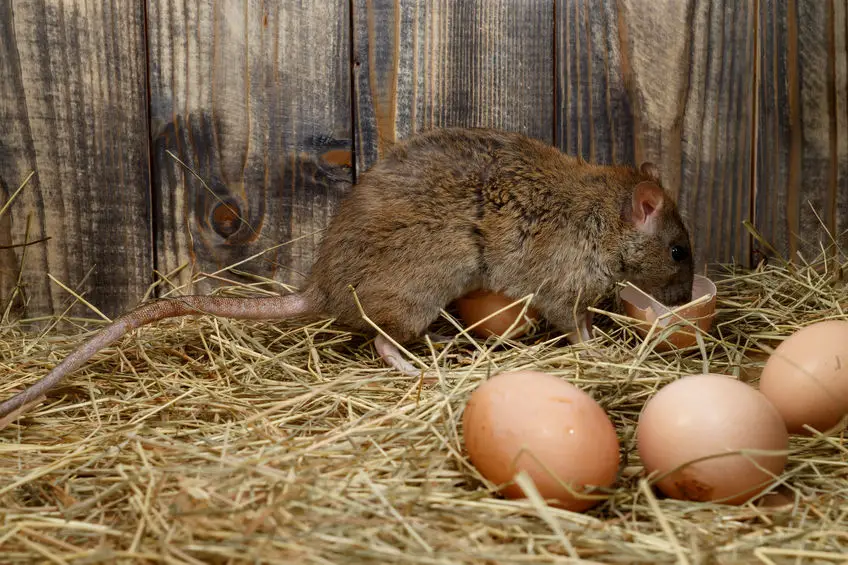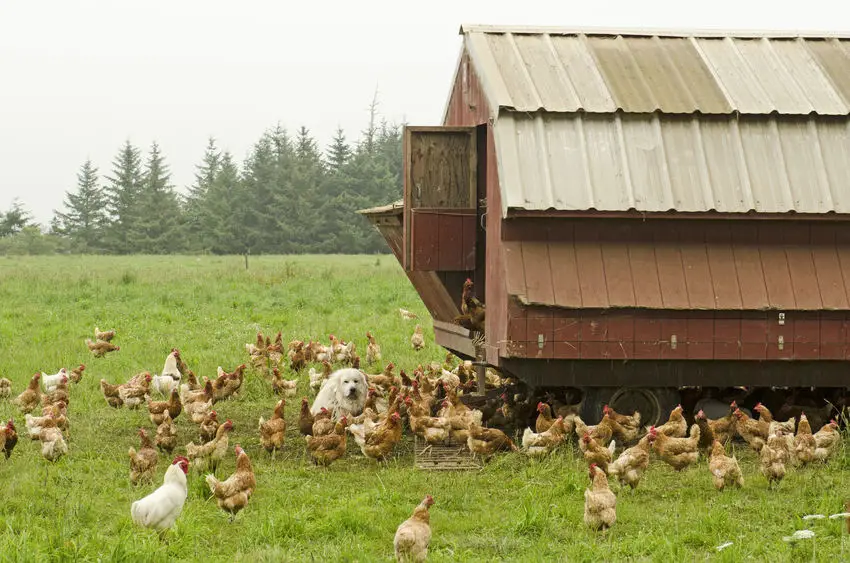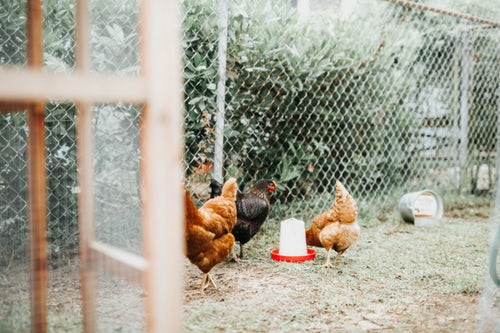Mobile Chicken Coop vs Stationary – What’s Best? It Depends
What’s better? A mobile chicken coop vs a stationary one? HELP! If you’re pondering this question and just can’t make up your mind, this article may be for you.
There really is no right or wrong answer when it comes to having a mobile chicken coop vs stationary but it’s helpful to know when each design is most useful. We hope to provide you with enough information in this article to make an informed choice.
As for level of difficulty in building either a mobile or stationary chicken coop, both can be difficult or easy, depending on the plan chosen. What determines complexity of building either model is how large the coop is. A large chicken coop CAN be put on wheels but it can add to the overall cost and building difficulty.
For more information on how to set up your coop, see our free guide.
In this article we’re going to tackle the pros and cons of both mobile and stationary coops. We are hoping this provides clarity in helping you decide which coop type will work best for you and your flock. Ok, let’s do this!

Pros And Cons Of A Stationary Coop
There are so many variables to consider when examining both stationary and mobile coops it can make your head spin! We’ll break down all the pluses and minuses of each, and you can decide which may be best for you and your flock.
PROS Of A Stationary Coop And Run
- Once it’s in place, you’re set! You won’t have to keep moving it all over the yard. It’ll have it’s own set up and place to rest.
- You can landscape around your coop – Once it’s in place, you can put in your favorite plants, borders, fencing, or whatever flare you’d like to add to it.
- A stationary position allows you to pick the perfect placement for your coop without the added hassle of moving it every now and then. More on finding the right coop positioning can be found here.
- Can be made more predatory proof – Any chicken coop can be predator proofed, but it’s a much simpler process with a stationary vs mobile coop. You can add large rocks around the perimeter of the run. You can also embed some hardware cloth skirting under it to keep predators from accessing your coop, or whatever predator proofing methods you prefer. This is not as easy to do with a mobile chicken coop.
CONS Of A Stationary Coop And Run
- The patch of grass where the coop is placed will be destroyed and likely have a few ruts and bumps from the chickens scratching out the dirt to create dust baths.
- You’ll have to add bedding to the run area on an ongoing basis to keep the area from getting muddy.
- Potential for rats/mice: This can happen to a coop whether it’s mobile or not, but the likelihood of attracting vermin increases if it’s in one place since it allows the unwanted critters to set up camp. With a mobile coop, that scenario is less likely since the coop is moved around with enough frequency that rats or mice won’t have time to get established. For information on getting rid of rats in a chicken coop, read this article.
- Chickens may get bored more easily – Looking at the same scenery day after day may get a bit monotonous, even for our feathered friends. Granted, as much as we love them, they aren’t terribly bright and may not be terribly bothered by this. But who doesn’t like a change of scenery now and then! In a mobile coop, they’ll have access to new grass, seeds, and bugs every so often. Chicken toys can help with this problem by spicing up their surroundings.

PROS Of A Mobile Coop
The pros of a mobile chicken coop are nearly the exact opposite of the cons of a stationary coop.
- Not only will your grass not be destroyed since the coop is moved regularly, it will get fertilized -This is a win-win for the chickens AND your lawn or pasture. The health of both your grass and flock will be improved.
- Less potential for vermin – Rats and mice can definitely be drawn to the feed in the coop, but the chance of them establishing a little (or large) family of their own, is less likely since the infrastructure is moving all the time.
- Chickens will always have something new to see and do -The benefits to your flock’s overall health can be wonderful with a mobile coop. Having access to fresh grass, bugs, etc., will improve egg or meat quality and keep your brood from getting bored!
- Bedding is not needed, at least in the run area (if you have one attached) – Chickens will spend the vast majority of time in the run during the day eating, scratching, and doing what chickens do. They’ll enjoy the grass all around them. On occasion, the bedding in the coop will need to be stirred or replaced, but not in the run. For information on coop bedding, see this post.
CONS Of A Mobile Coop
- Coop and/or run will have to moved regularly. This may not seem like a big deal in theory but if you forget to move the coop every few days, your lawn or pasture can get trampled or destroyed.
- It takes time to move the coop. It’s not a lot of time, but can become an inconvenience over the length of time you own your flock. Depending on how you have your coop set up, each time you move it you may also need to lift and move the feeders and water containers too.
- It takes effort to move the coop. If you have a small, lightweight coop, this may not be a major issue. But if your coop is large, moving it on a regular basis can be a lot of heavy work. If you need to use a tractor or other means to move the coop, it adds even more set up time getting out the tractor, starting it up, the hooking up to the coop to move it. Over time, this can be a laborious task. Again, it’s not a big deal (especially if we love our chickens), but a task that can get tiresome over time.
- Can be more difficult to keep out predators. This can depend on how you have your mobile coop set up. If you own a heavy coop/run with heavy gauge hardware cloth, it may not be a big deal. But if it’s lightweight, there’s a greater likelihood of digging in from under the run. More on predator control can be found here.
- Moving the coop can cause some of the materials to come loose or crack – Even if your chicken tractor is well made, the hardware, siding, etc. can come loose over time from the act of moving it. It’s generally not hard to re-secure screws, nails, etc. but is something to keep in mind.
Other Ideas
So far we’ve looked at the advantages and disadvantages of both mobile and stationary coops. But there are a few variations of the two that can also be considered. We’ll delve into that next.
Use A Stationary Coop But Let The Flock Free Range
We have used this strategy before and it’s worked well. Having over an acre of pasture, we built our coop near one edge of it and had the rest of the perimeter fenced off. Our hens were able to forage all day out in the grass, stopping at “home” occasionally to get some feed and water. If we were lucky, they may have even laid an egg before venturing back out again!
At night, they all returned to the coop to roost. This was an ideal setup for us. We didn’t have to spend a lot of time repositioning the coop, moving all the feeders, waterers, etc. The chickens loved it because they had a large area to explore!
We had to keep up with wing clipping or they’d fly over the fence or end up roosting in the trees that were also in the pasture.
Our Experience
We have primarily owned stationary coops, only one time using a mobile coop for some broilers we had. We found all the above pros and cons listed above to hold true. As with any decision we make, there are trade-offs.
With the stationary set up, there was an ease to it which was great. The chores involved simply checking feed and water, and gathering eggs each day. Since our system was automated, it was a simple job. On occasion we stirred the top layer of poop into the deep bedding as well. The coop was set up well to keep predators out, which occasionally came around at night.
When we used our mobile set up, it seemed like more work moving the coop during the week. But we felt the chickens were happy, appreciated all the fresh grass they got during the move, and it was nice to have that containment. The rest of the pasture was free and clear for our other livestock.

Experimentation – As with a lot of things in farming (and life) there is a fair amount of experimenting that happens when raising chickens. We’ve done ALOT of it over the past 15 years and continue to tweak and refine our chicken raising set up regularly. Don’t be afraid to do the same.
Tweaking your coop design may involve some trial and error. For example you may decide to make your coop stationary after you tried the mobile coop set up and it just didn’t work right.
Perhaps moving the coop took up too much time or the space to maneuver it was too tight. Or you didn’t like the droppings on the lawn after moving it, or moving the coop hurt your back ,etc.
These things happen! There will always be trial and error involved, and the process can be fluid like this until you get it the way that works the best. It’s all part of the joys of raising chickens.
Final Thoughts
We hope, at a minimum, we’ve provided you with enough ‘food for thought’ to help you make a decision that’s right for you. There is no “one size fits all” when it comes to raising chickens and setting up your coop so you’ll ultimately have to decide what will work best for you over time.
Building a chicken coop, whether it be mobile or stationary, is a fun yet challenging experience. We wish you the best in building your next mobile OR stationary coop. Happy ‘chickening!’







